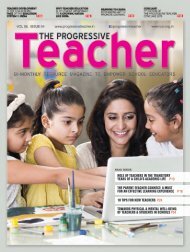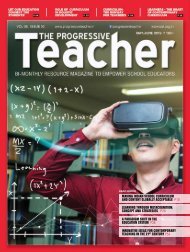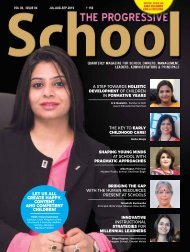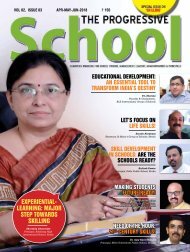The Progressive School Vol 01 Issue 04
The Progressive School is a quarterly magazine for school leaders, school owners, management, administrators and principals. It is set out to provide 'thought leadership' for progress and performance in schools.
The Progressive School is a quarterly magazine for school leaders, school owners, management, administrators and principals. It is set out to provide 'thought leadership' for progress and performance in schools.
You also want an ePaper? Increase the reach of your titles
YUMPU automatically turns print PDFs into web optimized ePapers that Google loves.
teaching-learning process and not to add<br />
to the frill value of a school. <strong>The</strong> level of<br />
technology integration was need-based<br />
and customized to suit the requirements<br />
of the students and teachers. <strong>The</strong> fact that<br />
technology freed us from a ‘one size fits<br />
all’ approach was a great boon even as<br />
we handled large class sizes. Technology<br />
and Smart Classrooms became a way of<br />
life and a mindset for us at school even<br />
as we enjoyed going beyond traditional<br />
boundaries.<br />
Using technology as a boon<br />
So how can the technology-enabled<br />
smart schools help solve the trickiest<br />
educational problems in a scalable,<br />
sustainable way? We all know that<br />
technology unevenly applied and<br />
inappropriately deployed, can cause<br />
more damage than benefit. Hence there<br />
is need for prudent and judicious use of<br />
the same. <strong>The</strong> following pointers could<br />
dispel the misgivings anyone could have<br />
about embracing technology in schools.<br />
• Use technology as a motivator for<br />
teachers to experiment and innovate.<br />
And not something to be feared.<br />
Create a culture in which new ideas<br />
thrive and are nurtured. This would<br />
require handholding and encouraging<br />
Avnita Bir<br />
new incumbents to step out of comfort<br />
zones.<br />
• Use technology to strengthen the<br />
human relationships between<br />
stakeholders. <strong>The</strong> greatest danger<br />
lies in the teacher’s personal touch<br />
being replaced by an animation or<br />
automated response system.<br />
• Use technology to improve/enhance<br />
the face time between the teacher<br />
and the taught.<br />
• Technology, creativity and pedagogy<br />
have to be made compatible for the<br />
smart class to be successful. It is<br />
at the intersection of all three that<br />
we can see innovation in education<br />
taking place. Remote centers of<br />
content or tech development in<br />
isolation of schools will not work.<br />
• Technology has to be simple,<br />
smooth, easy to use, almost invisible,<br />
supporting pedagogy, customizable,<br />
adaptive, not just student-centric but<br />
also teacher-centric.<br />
We are living in times of exponential<br />
and disruptive changes and the way to<br />
cope with the times is by being agile and<br />
adaptive in order to respond appropriately<br />
to the environment. Our children have<br />
never experienced the pre-Google era and<br />
as the world changes around us, we have<br />
to allow the winds of change to open our<br />
minds to new possibilities while at the<br />
same time being rooted in the human<br />
values that support us. It is imperative<br />
that schools approach the subject of<br />
technology and smart classrooms with<br />
due caution and integrate the same based<br />
on their school’s individual philosophy<br />
and culture.<br />
jul-AUG-SEP 2<strong>01</strong>7<br />
THE PROGRESSIVE SCHOOL<br />
11


















